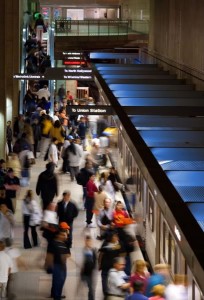
By John Addison (2/10/09)
Last year, Americans drove 100 billion miles less than the year before. They also used public transit and participated in commute programs in record numbers. Regional transportation plans have the opportunity to accelerate these trends, help people cost-effectively meet their transportation needs, and be part of the global warming solutions now needed.
In 2035, 9 million people will be more efficient and less stressed in traveling the San Francisco Bay Area if all goes according to plan. Transportation 2035 is one of the nation’s first regional transportation plans to make reducing carbon emissions integral to such a plan. This regional plan will accommodate a 26 percent population increase compared to 1990, improve their transportation, while reducing CO2 emissions by 14 percent compared to 1990.
Jack Broadbent, Executive Officer, Bay Area Air Quality Management District, observed, “Transportation is the largest source of air pollution and greenhouse gases in the Bay Area. To protect public health and protect the climate, we need to make better use of our transit systems, and we need to build and create livable communities that reduce our dependence on the automobile.”
Addressing the threat of a climate crisis is welcome in this multi-county region that includes cities, suburbs, ports, and an economy that includes manufacturing, services, agriculture, and diverse enterprises. Agriculture is already impacted by the draughts that impact vast parts of the United States. Rising seas threaten one of the nation’s most active ports and all living near the water.
“Climate change is expected to significantly affect the Bay Area’s transportation infrastructure through sea level rise and extreme weather. The transportation sector’s adverse contribution to climate change is primarily through greenhouse gas emissions from cars, trucks, buses, trains and ferries. Our transportation decisions and actions can either help or hinder efforts to protect the climate….”according to the Metropolitan Transportation Commission.
Most of the transportation budget will go to public transit which is forecasted to increase 75 percent over the 30 years. Clean Fleet Public Transportation Reports
The $226 billion of transportation funding over 30 years is primarily from local sources including transit fares, sales tax, and gasoline tax. Local, federal and state support is part of the funding, as it is throughout the nation.
In part, it is a demographic shift that will make the feasible the growth of public transportation. Although most people in the Bay Area now live in the suburbs, the Bay Area Governments forecast almost 70 percent growth in urban living and little growth in suburban living in the 30 years to 2035. Part of the shift to urban living is in the 25 percent of the Bay Area’s population that will be 65 and older in 2035. Similar percentages will be seen throughout the nation as 78 million U.S. Boomers are increasingly free from raising children and discover new priorities.
Planning trips will continue to get better. By Internet or a mobile phone call, trips can be planned via car or transit with systems like Google Maps and 511. Enter a beginning and end address, and these friendly information systems provide the best route, alternatives, and even include estimated walking time. Realtime transit arrival and traffic information will be ever more integrated into these systems.
Public transit is far less used in suburban and rural areas.
To speed suburban travel, an 800-mile Regional High-Occupancy Toll (HOT) Network on Bay Area freeways is mapped. The Plan states, “High-occupancy toll lanes, or HOT lanes for short, are carpool lanes with a twist: buses and carpools use the lanes free of charge, but solo drivers are allowed to use available capacity in the lanes, too — for a price.”
The estimated $3.7 billion construction cost of the network would be paid for with HOT toll revenues that are estimated at $6 billion. These lanes also allow commuter buses, vans, and carpools to get people to and from work much faster than driving solo.
I personal experienced the benefit of using a HOT lane a few months ago when attending the American Public Transportation Association (APTA TransitVision 2050) convention at the San Diego Convention Center. I was staying with family out in the suburbs where conventional wisdom dictates that public transportation does not work. My brother dropped me at a bus stop two-miles from his home. From there, I took a commuter bus that sailed past stop-and-go traffic in a HOT lane taking me to downtown San Diego where I hopped on a trolley to the Convention Center. The journey was faster than driving solo. The bus fare lower than parking cost.
HOT lanes are effectively deployed in Houston, Seattle, Denver, Miami, Minneapolis, and Salt Lake City.
Increased use of public transportation often hinges on those half to three “last miles” from home to transit to work. For many, the last mile solutions are walking and bicycling that improve health. Transportation 2035 thoughtfully includes Safe Routes to Transit programs and Safe Routes to Schools.
57 million Americans own a bicycle. The bicycle is especially effective for the last miles when simple things are in place such as painted and maintained bicycle lanes, secure bike parking, and sufficient space on buses and trains to carry a bicycle.
Although 30 percent of travel by bicycle is common in European cities from Copenhagen to Groningen. In the United States, however, Portland is the only city to even approach 3 percent. Transportation 2035 details a regional bicycle network to expand the carbon-free use of bicycles and improve the “last miles” solutions.
Better transportation for all of us certainly includes better expressways and bridges to somewhere, especially if they are significantly funded with tolls, HOT fees, and revenue tied to usage such as gasoline taxes. Ideally, better transportation is the result of a process that involves many employers, commuters, travelers, and governments throughout a region to plan effective multi-modal solutions. Transportation 2035 is one such plan.
